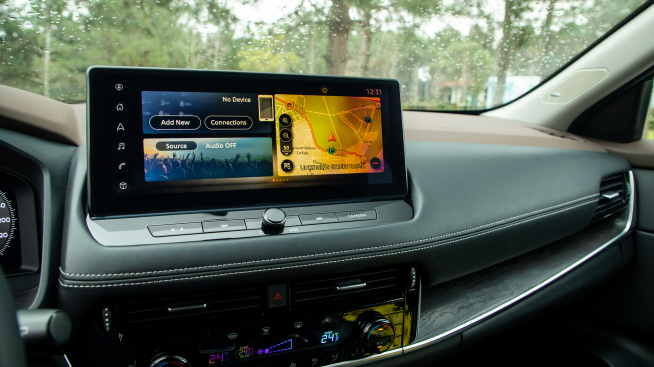What to look for on a test drive

When you go shopping for a new pair of shoes, you probably try them on and take a few steps around the store to see how they feel. Buying a car can be just as personal of a fit. That’s why it’s so important to test drive the car you’re thinking about buying. Taking a test drive can tell you a lot about a vehicle — if you know what to look for. Here are some things to take note of at the dealership to help make the most out of your test drive.
Before your test drive
Let’s look at how you can help set yourself up for success before you even arrive at the lot.
Schedule appointments
To get a good deal, it’s recommended to consider multiple vehicles and shop around at several dealerships. It’s also helpful to schedule appointments for your test drives ahead of time to help ensure the car you want is still available and to possibly spend less time waiting. Calling ahead can also show dealers that you’re serious about buying and not just casually browsing.
It may also be practical to schedule a few test drives in the same day or week. This can help keep your impressions of each vehicle fresh in your mind so you can make more accurate comparisons.
Check out the car thoroughly
Once you arrive on the lot and the car is brought out, it’s important to check it, both inside and out. Here’s a short list of things you may want to get a good look at:
- Cosmetic details like paint and general body work.
- The condition of the interior cabin and the seating spaces. Test out the seats in the front and the back of the car so you also get an idea of what the passenger experience will be like.
- Visibility of windows and mirrors and functionality of seatbelts, seat adjusters, and stereo equipment.
- Layout and appearance of the dashboard.
- If there are additional tech features like Bluetooth, onboard cameras or infotainment systems, ask the salesperson for a walkthrough of these.
Simulate your daily conditions
In order to get the most out of your test drive, it helps to try to simulate your daily driving conditions as much as possible. If you use car seats for small children, bring those seats with you to be sure they fit securely in the car. If your job requires you to carry certain tools or equipment, take measurements of those items or bring them with you when you test drive the car, along with a tape measure. This helps you check if the vehicle can safely accommodate those items. Additionally, you may want to take note of the weight of bulky items or anything you need to tow and check that against the vehicle’s towing capacity.
Some dealerships restrict customers to a set route for a test drive, but you may be able to make a polite request to set your own route to mimic your daily drive a bit better. If you regularly drive through hilly areas or put in a lot of highway miles, for instance, you may want to try to see how the car handles those situations.
Take copious notes at every stage
Having some kind of record of your impressions can go a long way toward ensuring the test drive was a productive use of your time, especially if you end up having more than one that day.
You could try asking a friend or partner if they’d be willing to join you and take notes on your behalf as you test drive the car. They could also be a great source of information about the passenger experience if you plan to regularly have other people in the car with you. Of course, you could always take your own notes before and after your test drive. Don’t discount your reactions, either. A minor nuisance today could become a major annoyance over time, so take note of even the littlest things that stuck out in your mind.
Do you need insurance to test drive a car?
Before hopping in the driver’s seat, you may be wondering if you need insurance to test drive a car. Dealerships typically won’t ask for proof of insurance during your test drive, but note you’ll need to show proof of insurance to finalize the sale should you want to purchase the vehicle.
How to test drive a car
Next, let’s look at what happens during the test drive. This is where the pedal hits the metal, literally, and it’s where you’ll get the most information about the actual driving experience. Sometimes, this can be where buyers realize a car they thought was so-so on paper is spectacular on the road. Here’s what to get a feel for:
- Brakes and acceleration: These are both critical to your driving experience and safety. As you drive, take note of how the car brakes and accelerates. Is it appropriately responsive for your style of driving or will it require significant re-adjustment on your part?
- Steering and handling: Similar to brakes and acceleration, the steering and overall handling of the vehicle should feel comfortable to the way you tend to drive. Does the steering feel smooth, or do you have to wrestle with it? Can it handle sharp turns like highway off-ramps? Is it easy to park?
- Cabin and driver’s seat: You'll be spending almost all your time in the car here, so take note of your impressions of the cabin and driver’s seat as you drive. Is it quiet and comfortable? Can you get in and out of the driver’s seat easily? Are the dashboard lights and symbols easy to understand as you’re driving?
- Tech features: Features like backup cameras or Bluetooth connection may sound great, but not if the footage is grainy or the Bluetooth never wants to connect to your device. These additional features should enhance your driving experience, not hinder it.
In addition to the above, it’s also helpful to keep an ear out for any odd noises. A new car in good condition should typically be fairly quiet as it drives, so note any odd noises you notice as it drives. These could indicate some kind of mechanical defect in the vehicle.
After your test drive
Once you’re back at the dealership, you may want to follow up on a few points such as:
- Whether there's a warranty on the car and what the terms and coverage are.
- The car’s fuel requirements and any other specifics about servicing and maintenance, such as recommended maintenance schedules.
- Whether you’re allowed to bring the car to your own mechanic for a second opinion before buying. This should generally be acceptable in most cases and refusing this request could be a potential red flag.
- The possibility of an extended test drive, which lets you take the car home overnight or for a few days so you can really get a feel for it.
If the test drive goes smoothly, there’s a chance your salesperson might assume you’re ready to talk about the details. It’s okay to let them know if you’re not quite ready for that conversation yet. You can head out to your next test drive appointment or review your notes thoroughly back at home. Taking the time you need to collect your thoughts can help you make a more informed choice. The dealer should be a trusted teammate in your car buying journey. Don’t be afraid to ask them questions and lean on them for expertise and guidance.
Buying from a private seller?
Taking a test drive when you’re buying a car from a private seller isn’t that much different from buying a new car at a dealership. Scheduling an appointment for the test drive may become mandatory, as you may not be able to just pull up to someone’s house unannounced the way you could at a dealership.
Since it’s a used car, you may also want to inquire about a vehicle history report to help ensure the car hasn’t been in any major accidents or undergone drastic repairs. Bringing a friend along may help give you an added sense of safety, and, as you learned above, they can also be useful for helping you record your impressions.
In summary
Making the most out of your test drive is really a matter of being conscientious and thoughtful. Before you test drive a car, you can save yourself some time by scheduling appointments so the car is ready and waiting for you when you get there. When you arrive, it’s best to examine the car thoroughly — inside and out, front and back. It also helps to take note of everything that sticks out (good or bad) and to record those notes somewhere you can easily reference later. Car shopping is a personal process, and a thoughtfully conducted test drive can help identify the perfect car for you.



